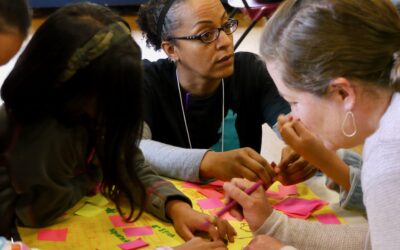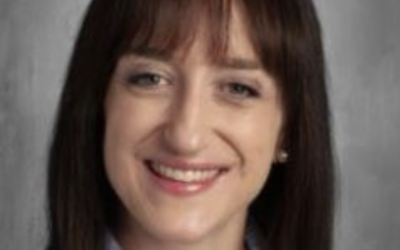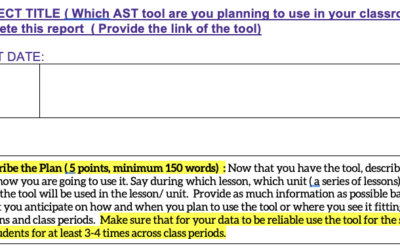
These videos are part of a Legacy Series, meaning that they were produced earlier than the other case studies you see on this website. These have been so popular with our viewers that we’ve included them here.
Brian’s 9th grade physical science textbook includes a long unit of instruction about waves and energy presented through multiple chapters of text. The chapter about waves covers many different kinds of waves and includes formulas for calculating properties such as frequency. The chapter about sound covers everything from sound intensity to echolocation to the Doppler Effect. An overwhelming number of topics are addressed in paragraph after paragraph of expository text with few opportunities to students examine science ideas for themselves.
Instead of following the textbook page by page, Brian decided to focus on helping students understand how mechanical energy can transfer from something like a vibrating guitar string, drum head, or tuning fork into compressional waves of sound energy traveling through air. He also wanted to help students understand how two qualities of the sounds that we hear – pitch and volume – are caused by properties of frequency and amplitude in waves. Once students have made sense of these central ideas about waves, energy, and sound, Brian plans to investigate other sound events like echoes, sound-proof rooms, and the Doppler Effect. By taking a theory focus, rather than a topic focus for this unit of instruction, Brian hoped that students would construct theories of sound and waves that could be used to understand many different events in their lives.
Brian used a number of models to help students understand and explain sound events. First students constructed their own models about how musical instruments and tuning forks create sounds that can travel through the air to listeners. Second, Brian introduces representations of sound waves as compressions in a Slinky toy and as compressions in air particles to help students think about how unobservable processes, like energy transferring through collisions between air particles, are responsible for the observable qualities of sound that we hear when musical instruments are playing or when a tuning fork is ringing.
Finally, students synthesized their own representations of sound with representations that they picked up throughout the unit in order to generate final models and explanations for differences heard in the pitch and volumes of various instruments at a concert venue.
Pre-unit interview
Brian (Mr. Coffey) constantly “works on students’ ideas.” Throughout this unit of instruction, he worked to help students translate between images of sound as a transverse wave as seen many representations of sound and an explanatory model of sound as a compressional wave moving through a medium like air. While the transverse wave representation is often used in order to depict wavelength, frequency, and amplitude, Mr. Coffey is concerned that transverse wave images fail to help students understand the actual behavior of sound waves in a medium like air.
By developing a model of sound as energy waves passing through the collisions and compressions of particles in air, Mr. Coffey provided a solid conceptual foundation for students to explain how sound works in general, and to explain specific features of sounds like pitch and volume. In addition, Mr. Coffey worked to help students develop a model of sound energy transferring in all directions from a point of origin rather than traveling directly from the point of origin to the listener. This model of sound energy traveling in three dimensions will be important in later units of study when students work to understand phenomena like echoes and the Doppler Effect.
Day 1 Eliciting ideas about sound
Eliciting ideas about sound from musical instruments
1) Warm-up questions: Three musical instruments are pictured on PowerPoint slide: an acoustic guitar, kick drum from a drum kit, and a flute. Students write in their science journals about two questions:
- Describe the sounds that each instrument makes.
- How does each instrument make sound?
Brian (Mr. Coffey) collects students’ ideas on a chart on a piece of butcher paper at the side of the classroom trying to get students to verbalize their knowledge of sound and music and to elaborate on their initial responses.
2) Musical instrument demonstration: Student volunteers come to the center of the classroom and play a few sounds on a stand-up bass and a tri-tom drum set. Mr. Coffey plays a couple of different wind instruments that are part of his personal collection. This demonstration created a shared experience with music and helped to get students engaged in thinking about sound.
3) Initial diagram models of sound from a musical instrument: Students work in small groups to create posters of a musical instrument showing how it makes sound, how the sound travels to a listener, and how people hear sounds. Mr. Coffey goes to each table and talks with students. First he talks about the nature of the task itself to make sure that students understand what they are supposed to be doing with their posters. Then he visits each table and asks questions about what he sees on their posters or what he hears them talking about with their partner. His questions are directed towards eliciting students’ ideas about the nature of the sound itself and about the way that sound travels.
Discussion questions for teachers: 1) Mr. Coffey chose to spend 2 days eliciting students’ ideas about sound in 2 different ways. What are students’ initial understandings about sound from musical instruments? 2) How does he uncover these ideas? What kinds of questions does he ask when students give incomplete responses or reveal an alternative conception? What does he do when he first enters a group/ exits a group?
Day 2 Eliciting ideas using tuning forks
Eliciting ideas using tuning forks
1) Warm-up questions: Three musical instruments are pictured on PowerPoint slide: an acoustic guitar, kick drum from a drum kit, and a flute. Students write in their science journals about two questions:
- Describe the sounds that each instrument makes.
- How does each instrument make sound?
Brian (Mr. Coffey) collects students’ ideas on a chart on a piece of butcher paper at the side of the classroom trying to get students to verbalize their knowledge of sound and music and to elaborate on their initial responses.
2) Musical instrument demonstration: Student volunteers come to the center of the classroom and play a few sounds on a stand-up bass and a tri-tom drum set. Mr. Coffey plays a couple of different wind instruments that are part of his personal collection. This demonstration created a shared experience with music and helped to get students engaged in thinking about sound.
3) Initial diagram models of sound from a musical instrument: Students work in small groups to create posters of a musical instrument showing how it makes sound, how the sound travels to a listener, and how people hear sounds. Mr. Coffey goes to each table and talks with students. First he talks about the nature of the task itself to make sure that students understand what they are supposed to be doing with their posters. Then he visits each table and asks questions about what he sees on their posters or what he hears them talking about with their partner. His questions are directed towards eliciting students’ ideas about the nature of the sound itself and about the way that sound travels.
Discussion questions for teachers: 1) Mr. Coffey chose to spend 2 days eliciting students’ ideas about sound in 2 different ways. What are students’ initial understandings about sound from musical instruments? 2) How does he uncover these ideas? What kinds of questions does he ask when students give incomplete responses or reveal an alternative conception? What does he do when he first enters a group/ exits a group?
Days 3 & 4 Building background knowledge
1) Warm-Up Question: If you could make a bumper sticker with just the most important information from your reading, what would your bumper sticker say? A PowerPoint slide shows an image of mini-van covered in bumper stickers and prompts students to create their bumper sticker slogans about sound. After a few moments of writing time, Mr. Coffey elicits a couple of students’ bumper sticker summaries and writes them up on the document camera.2) Modeling How to Have a Discussion About Text: Mr. Coffey is concerned that students may not really know how to synthesize their ideas together to answer the jigsaw questions – he’s worried that they might just take turns writing answers onto their jigsaw answer sheet without having any discussion – so he models a discussion using one group.
3) Group Discussions about Readings: Table groups consisted of at least three people. Each person became an expert about one facet of a big idea about sound, waves, air, and hearing. They worked together synthesizing ideas and information from their reading packets to answer a set of questions about sound. While the students discussed the readings, Mr. Coffey talked with them and eventually brought out Slinky toys to help act out sound waves with low/high pitch and low/high volume.
Discussion questions for teachers: 1) Mr. Coffey felt that having the Slinky toys readily available during this lesson was critical for helping to shape student thinking about sound waves. How did Mr. Coffey & the students use the Slinky toys to help think about sound? 2) What issues of academic language and literacy surface in this lesson? 3) What are some partial understandings that students develop during this lesson? What are some ideas that continue to present challenges for students?
Day 4 Building knowledge continued
1) Whole Class “Just in Time” Instruction: To further assist students in building background knowledge about sound, Mr. Coffey reviews three ideas about sound:
- How things make sound by vibrating and colliding with air.
- How sound travels as a compressional wave of energy through collisions in air particles.
- How the frequency and amplitude of sound waves result in differences in pitch and volume that we hear as qualities of sounds.
Mr. Coffey strategically uses PowerPoint slides with images of sound as movement of energy through collisions of particles of air to help students work towards a compressional wave models of sound and to help students envision the difference between amplitude and frequency in compressional waves. In addition, Mr. Coffey again brings out the Slinky toys to help act out various sounds. The Slinky image of sound waves continued to be a powerful learning experience for many students.
2) Revising Initial Music Models with Additional Science Content: Students use the last few minutes of class to revise their initial ideas about sound traveling from a musical instrument. Instead of having students write or draw on their posters directly, Mr. Coffey has them add new ideas or revisions by writing or drawing on Post-It Notes. This allows Mr. Coffey to quickly distinguish between students’ initial ideas and their subsequent revisions.
Discussion questions for teachers: 1) Which concepts has Mr. Coffey chosen to emphasize at this point in the unit? Why? 2) How have students added science ideas to their initial models of sound? In what ways have students’ ideas changed? Are any students holding on to alternate explanations or ideas at this point in the unit? 3) How does Mr. Coffey adapt his conversations with students depending on the level of understanding expressed by different groups of students?
Days 5 & 6 "Seeing" Compressions, Pitch, and Volume
Making Sense of Sound Waves: Helping Students See Compressions, Pitch, and Volume
1)Warm-Up Question & Rubens’ Tube Demonstration:
Mr. Coffey asks students to draw how they predict the particles of propane gas will be arranged inside of a tube connected to a speaker if a sound is played into the tube. He has students come to the chalkboard to draw their ideas. He then demonstrates a few different sounds with the Rubens’ Tube apparatus to help students visualize how the particles of gas are arranged differently when different sounds are made. This demonstration proves to be critical for students’ sense-making about how a compression travels through a gas transferring energy.
2)Garage Band: Using Technology to Collect Data about Pitch & Volume:
Mr. Coffey teaches students to utilize the GarageBand program on their laptops to collect information about how the sounds from tuning forks vary when the sound travels across different distances for different periods of time. Students record information about the volume (or strength) of the sounds and the pitch (or key) of the sound from two different tuning forks. Students then draw diagrams of sounds with different pitches and volumes using two representations: 1) sound seen as a pulse moving through a Slinky toy, and 2) sound seen as a compression moving through air particles. You can see a sample of student work on the Investigating Pitch and Volume assignment. Mr. Coffey circulates throughout the GarageBand lessons using backpocket questions to help connect the activity to students’ emerging ideas about sound and to push students to continue to refine their models of how sound works.
Discussion questions for teachers: 1) The Rubens’ Tube demonstration ultimately proves to be very important for student thinking about sound waves. Why is this demonstration important for helping students make sense of sound? What is it exactly that this demonstration helps illustrate & what evidence does the Rubens’ Tube provide? 2) In what ways are students’ ideas about sound beginning to shift compared with their original drawings of musical instrument s and tuning forks? In what ways are some students still struggling to understand sound?
Day 7 Using evidence to construct explanations
1) Day 7 Warm-Up Question: Mr. Coffey asks students to reflect on the various experiences that they have had in class so far and evaluate which of the experiences has been important in changing their thinking about sound.
2) “Evidence Buckets” Introduction: Mr. Coffey draws attention to the various experiences students have had throughout the week by showing them four posters showing four “buckets” of evidence. He prompts students to synthesize multiple pieces of evidence across multiple experiences as they work with small groups to construct an explanation for either the difference in pitch or the difference in volume between drums. This small group project includes a high degree of scaffolding to support students’ use of academic language during the construction of their evidence-based scientific explanations.
3) Small Group Discussions to Construct Explanations: Groups of students discuss the questions and the evidence in order to construct written explanations and diagrams of drums producing either two different pitches of sound or two different volumes of sound.
Discussion questions for teachers: 1) Both of Mr. Coffey’s Warm-Up questions during this lesson are metacognitive questions – questions that push students to think about their own thinking and learning. What are some of the reasons why a teacher might use metacognitive questions? How is this related to ideas from How Students Learn Science in the Classroom? 2) Scaffolding is supposed to help students accomplish tasks and understand ideas that they otherwise may not have been able to accomplish on their own. How did Mr. Coffey utilize scaffolding throughout this lesson to help all students – even those who are still struggling – complete the evidence-based explanation assignment?
Day 8 Using evidence to construct explanations
Using evidence to construct scientific explanations of pitch & volume of sounds – small group project
Continues from Day 7…
4) Day 8 Warm-Up Question: Mr. Coffey asks students to reflect on what is difficult about the group assignment and what is going well so far.
5) Small Groups Present their Evidence-Based Explanations: Mr. Coffey selects a few small groups from each class to share their written explanations and their drawings for the “Explaining Sound” assignment.
Discussion questions for teachers: 1) Both of Mr. Coffey’s Warm-Up questions during this lesson are metacognitive questions – questions that push students to think about their own thinking and learning. What are some of the reasons why a teacher might use metacognitive questions? How is this related to ideas from How Students Learn Science in the Classroom? 2) Scaffolding is supposed to help students accomplish tasks and understand ideas that they otherwise may not have been able to accomplish on their own. How did Mr. Coffey utilize scaffolding throughout this lesson to help all students – even those who are still struggling – complete the evidence-based explanation assignment?
Day 9 Constructing evidence-based explanations
1) Warm Up Question: Mr. Coffey shows two tuning forks of different lengths on the projector. He asks students to provide descriptions, explanations, and drawings showing the differences in sounds that would be heard when these two tuning forks are ringing. Mr. Coffey puts a few samples of student work under the document camera to share their responses. This provides one last opportunity for students to refine their thinking before starting their individual assessments.
2) Individual Evidence-Based Scientific Explanations: Students work on a writing assignment where they explain how two listeners (one in the front row and one in the back row) at a rock concert would hear sounds from different instruments. Mr. Coffey builds off of students’ previous group assignment and asks slightly different questions on the individual assignment: Explaining Sound at a Concert.
Discussion questions for teachers: 1) How does Mr. Coffey use this lesson to help students wrestle with unobservable ideas that the students had not necessarily considered to date? 2) What other phenomena might students be able to explain now? 3) How does the scaffolding on this individual assignment compare with the scaffolding provided on the previous small group assignment? Why did Mr. Coffey make these assignments slightly different? 4) Create an explanation rubric and evaluat students’ evidence-based explanations of sound heard at a concert, detailing partial as well as complete understandings.




 This site is primarily funded by the National Science Foundation (NSF) through Award #1907471 and #1315995
This site is primarily funded by the National Science Foundation (NSF) through Award #1907471 and #1315995